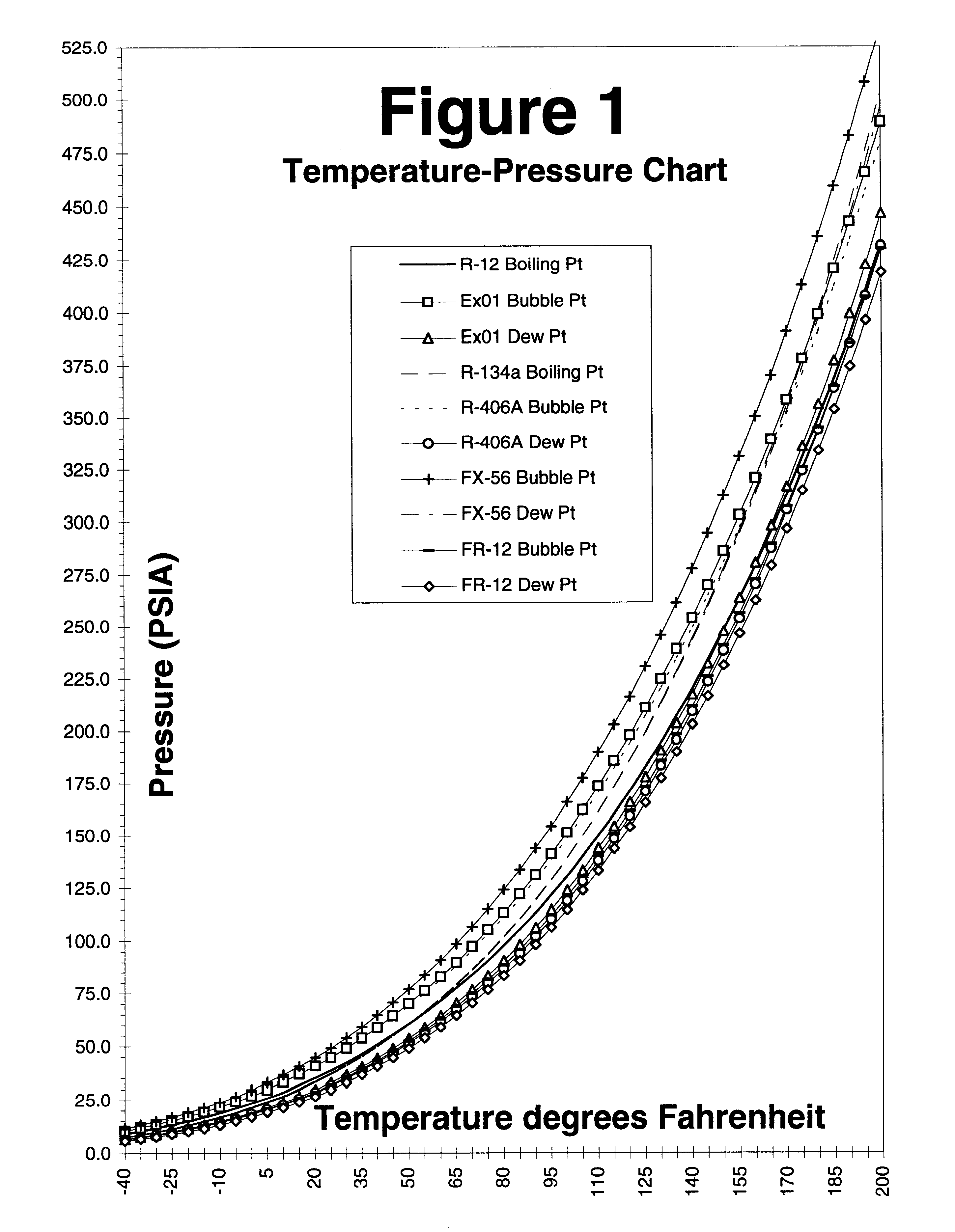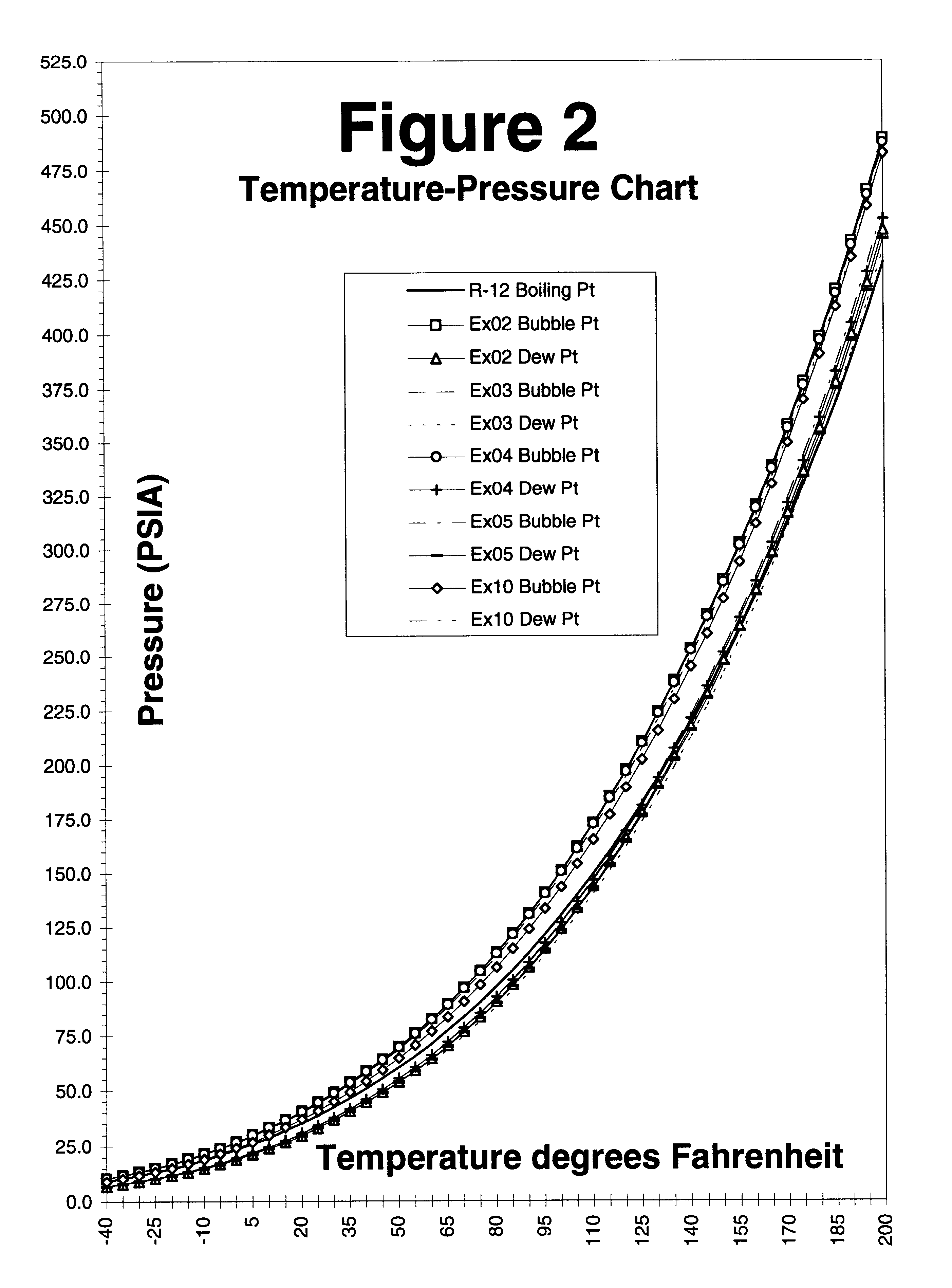Drop-in Substitutes for dichlorodifluoromethane refrigerant
a technology of dichlorodifluoromethane and drop-in substitutes, which is applied in the direction of heat exchange elements, chemistry apparatuses and processes, etc., can solve the problems of premature failure, catastrophic compressor failure, and most pag oils cannot tolerate even minute traces of residual chlorides, so as to achieve little stratospheric ozone damage and little global warming damage
- Summary
- Abstract
- Description
- Claims
- Application Information
AI Technical Summary
Benefits of technology
Problems solved by technology
Method used
Image
Examples
example 1 (
A MOST PREFERRED EMBODIMENT)
25 pounds of R-600a / 142b / 124 / 22 4 / 16.5 / 28.5 / 51 (ODP=0.0449 GWP=1334), a “drop-in” substitute refrigerant for an R-12 automotive air conditioning system, were blended into a mixing cylinder (30 lb “disposable” DOT-39 cylinder manufactured by Worthington Cylinders) with a dip tube using the methods and procedures described above. Flammability suppression was desirable and the higher evaporator temperatures in a car (32 degrees Fahrenheit and above) resulted in good oil miscibility, even with higher percentages of R-124 (lower percentages of R-142b). There was less flammability suppression and more oil miscibility than in Example 2, below. The refrigerant mixture of this Example (minus the oil) has been found to be nonflammable, even after worst case vapor leakage (fractionation), at cold temperatures (−10 F. range), with worst cases (highest concentrations of flammables) points tested for flammability at 100 degrees Centigrade with methods specified by Unde...
example 2
R-600a / 142b / 124 / 22 4 / 13 / 33 / 50, a “drop-in” substitute refrigerant mixture for an R-12 automotive air conditioning system, is created in the manner set forth in Example 1 above. Flammability suppression is desirable and the higher evaporator temperatures in a car (32 degrees Fahrenheit and above) results in good oil miscibility, even with higher percentages of R-124 (lower percentages of R-142b). The blend in this Example was computer simulated with NIST program REFPROP V4.0 and showed good results.
Compared to R-406A, the Example 2 refrigerant mixture offers about 20 percent lower ozone depletion and about 30 percent less global warming.
R-600a / 142b / 124 / 224 / 13 / 33 / 50ODP = .043 GWP = 1268 (Example 2)R-600a / 142b / 224 / 41 / 55ODP = .0546 GWP = 1755 (R-406A forcomparison)
example 3
R-600a / 142b / 124 / 22 4 / 34 / 7 / 55, a “drop-in” suite for R-12 in a walk-in freezer, operating at −20 degrees Fahrenheit, is created in the manner set forth in Example 1 above. Due to the low evaporator temperature, oil miscibility is of paramount importance. A higher percentage of R-142b and a lower percentage of R-124 are used. Computer simulations showed good results.
The Example 3 refrigerant mixture offers about same ozone depletion and global warming as R-406A. Any weak flammability which might result from a vapor leak of R-406A under cold temperatures is reduced.
R-600a / 142b / 124 / 224 / 34 / 7 / 55ODP = .052 GWP = 1648 (Example 3)R-600a / 142b / 224 / 41 / 55ODP = .0546 GWP = 1755 (R-406A forcomparison)
PUM
 Login to View More
Login to View More Abstract
Description
Claims
Application Information
 Login to View More
Login to View More - R&D
- Intellectual Property
- Life Sciences
- Materials
- Tech Scout
- Unparalleled Data Quality
- Higher Quality Content
- 60% Fewer Hallucinations
Browse by: Latest US Patents, China's latest patents, Technical Efficacy Thesaurus, Application Domain, Technology Topic, Popular Technical Reports.
© 2025 PatSnap. All rights reserved.Legal|Privacy policy|Modern Slavery Act Transparency Statement|Sitemap|About US| Contact US: help@patsnap.com



